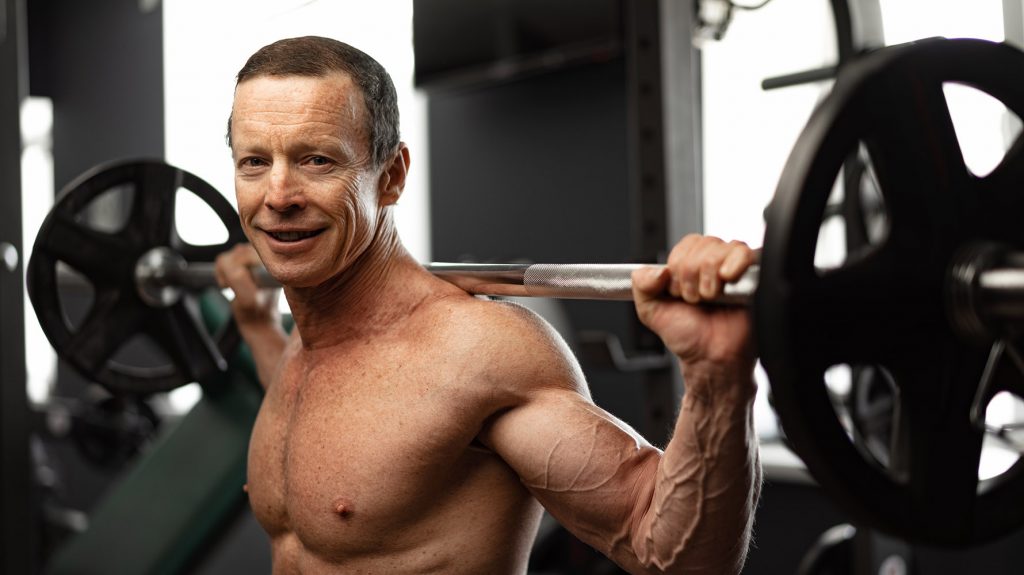Plate Raises is a variant of lifting a weight in front of you in which the athlete uses a barbell plate as a weight. This exercise will help to add variety to the training of the shoulder muscles and upper body.
Table of Contents
What Muscles Do Plate Raises Work?
Plate Raises is an isolation exercise performed while standing. The main purpose of this exercise is to put a load on the anterior bundle of the deltoid muscle.
In addition to the anterior deltoid muscle, the trapezius muscles are also active.
They experience maximum stress when the arms are positioned parallel to the floor and higher.
Also, the forearms are loaded in a static position. They help keep the weights in your hands.
The loin and abs work here in a static mode. They stabilize the body.
How To Do Plate Raises?
- Stand up straight. Hold the plate with both hands. The palms are directed towards each other, and the arms are extended and slightly bent at the elbows. Keep the plate in front of you as far as you can. The arms remain in this position throughout the entire movement. This will be the starting position.
- As you exhale, slowly raise the plate to just above your shoulders. Hold at the top point for a second. Make sure not to rock the plate or bend your elbows. The body remains stationary.
- While inhaling, gently lower the plate back to the starting position.
- Do the recommended number of reps.
Features of Exercise
The heavier the barbell plate, the larger its diameter. This unfortunately imposes certain nuances to the implementation of the exercise.
As a result, when the edge of the plate rests on the hips in the lower phase of the movement, it leads to a slight decrease in the amplitude of motion.
It is advisable that the bottom of the plate does not touch the hips. By using this technique, the exercise is more difficult to do, as it provides the anterior deltoid muscles with constant tension. This is beneficial for their growth.
Do the movement in full amplitude if you want to get a comprehensive development of the entire shoulder girdle (anterior deltoid and trapezius muscles). Raise your hands as high as possible until the barbell plate is almost above your head.
But in most cases, Plate Raises are used for targeted training of the anterior deltoid muscle. In this case, the hands are raised no higher than the level of the eyes.
Main Mistakes
The following common mistakes are typically made when doing Plate Raises:
- Using too heavy weight. This causes the athlete to involuntarily engage stronger muscles. As a result, the workload is dissipated between them while reducing efficiency.
- The use of cheating. The athlete rocks and tilts the torso back and forth during the exercise. Many people use cheating specifically to lift a heavier weight due to the strength of the back. Others use it unconsciously at the end of the set when there is no strength left to finish the exercise in the technically correctly manner.
- Fast and jerky pace of execution. The pace of movement should be slow and controlled as the exercise is isolating. This allows for better muscle development.

Plate Raises: Pros and Cons
The features of Plate Raises are typical for many isolating exercises.
Pros
The main advantages:
- The ability to focus on the anterior bundle of the deltoid muscle.
- The exercise is suitable for sculpting and better detailing of the anterior deltoid muscle.
- A more comfortable position of the hands is achieved compared to the option when using a barbell.
Cons
The disadvantages include:
- Not suitable for increasing the muscle mass of the shoulders.
- Does not develop shoulder girdle strength.
- Not all barbell plates are suitable for the exercise.
- Limited weight.
Plate Raises in Workout Programs
The use of Plate Raises depends on your training goals:
- This exercise is used infrequently in the bulking cycle.
This is due to the fact that the anterior deltoid muscle is the most massive and strong of all three bundles of the shoulder. It rarely lags behind in its development.
Therefore, the main training load is directed at the lagging middle and posterior bundles of the deltoid muscles during the period of work on muscle volume.
Plate Raises are typically performed at the end of a shoulder workout if there is a need to work on the anterior deltoid muscle. This is enough for this muscle to start developing.
- When on a cutting cycle, the anterior deltoid muscle is trained both at the beginning of the shoulder workout and in the middle or end.
It all depends on the degree of development of this muscle bundle, as well as the presence of visual separation of the muscle (visible separation of the anterior deltoid muscle from the upper chest) in how you will choose to train it.
High-reps are typically used to achieve this goal. 15-20 reps per set.

